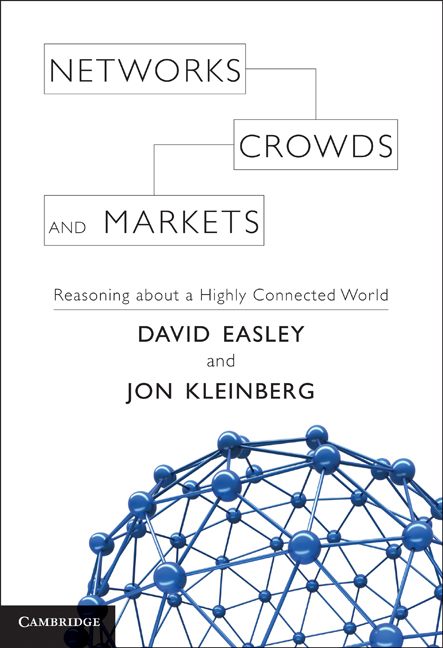David Easley, Jon Kleinberg: Networks, Crowds, and Markets: Reasoning About a Highly Connected World (2010)
Filed under book | Tags: · game theory, graph theory, intellectual property, mathematics, networks, web 2.0

Are all film stars linked to Kevin Bacon? Why do the stock markets rise and fall sharply on the strength of a vague rumour? How does gossip spread so quickly? Are we all related through six degrees of separation? There is a growing awareness of the complex networks that pervade modern society. We see them in the rapid growth of the Internet, the ease of global communication, the swift spread of news and information, and in the way epidemics and financial crises develop with startling speed and intensity. This introductory book on the new science of networks takes an interdisciplinary approach, using economics, sociology, computing, information science and applied mathematics to address fundamental questions about the links that connect us, and the ways that our decisions can have consequences for others.
Publisher Cambridge University Press, 2010
ISBN 0521195330, 9780521195331
736 pages
Joe Karaganis (ed.): Media Piracy in Emerging Economies (2011) [EN, RU, ES, CN]
Filed under report | Tags: · bolivia, brazil, copyright, culture industry, digital media market, filesharing, india, intellectual property, market, mexico, p2p, piracy, russia, south africa

“Media Piracy in Emerging Economies is the first independent, large-scale study of music, film and software piracy in emerging economies, with a focus on Brazil, India, Russia, South Africa, Mexico and Bolivia.
Based on three years of work by some thirty-five researchers, Media Piracy in Emerging Economies tells two overarching stories: one tracing the explosive growth of piracy as digital technologies became cheap and ubiquitous around the world, and another following the growth of industry lobbies that have reshaped laws and law enforcement around copyright protection. The report argues that these efforts have largely failed, and that the problem of piracy is better conceived as a failure of affordable access to media in legal markets.
“The choice,” said Joe Karaganis, director of the project, “isn’t between high piracy and low piracy in most media markets. The choice, rather, is between high-piracy, high-price markets and high-piracy, low price markets. Our work shows that media businesses can survive in both environments, and that developing countries have a strong interest in promoting the latter. This problem has little to do with enforcement and a lot to do with fostering competition.””
Publisher The Social Science Research Council (SSRC), 2011
Distributed under a Consumer’s Dilemma license
ISBN 978-0-98412574-6
440 pages
PDF (English, added on 2018-5-11)
PDFs (4 languages, from publisher; updated 2015-5-14)
See also Shadow Libraries: Access to Knowledge in Global Higher Education, 2018.
Comments (3)Janet Hope: Biobazaar. The Open Source Revolution and Biotechnology (2008)
Filed under book | Tags: · biotechnology, copyleft, floss, intellectual property, open source, software, technology

Fighting disease, combating hunger, preserving the balance of life on Earth: the future of biotechnological innovation may well be the future of our planet itself. And yet the vexed state of intellectual property law–a proliferation of ever more complex rights governing research and development–is complicating this future. At a similar point in the development of information technology, “open source” software revolutionized the field, simultaneously encouraging innovation and transforming markets. The question that Janet Hope explores in Biobazaar is: can the open source approach do for biotechnology what it has done for information technology? Her book is the first sustained and systematic inquiry into the application of open source principles to the life sciences.
The appeal of the open source approach–famously likened to a “bazaar,” in contrast to the more traditional “cathedral” style of technology development–lies in its safeguarding of community access to proprietary tools without discouraging valuable commercial participation. Traversing disciplinary boundaries, Hope presents a careful analysis of intellectual property-related challenges confronting the biotechnology industry and then paints a detailed picture of “open source biotechnology” as a possible solution. With insights drawn from interviews with Nobel Prize-winning scientists and leaders of the free and open source software movement–as well as company executives, international policymakers, licensing experts, and industry analysts–her book suggests that open source biotechnology is both desirable and broadly feasible–and, in many ways, merely awaiting its moment.
Publisher Harvard University Press, 2008
ISBN 0674026357, 9780674026353
428 pages

